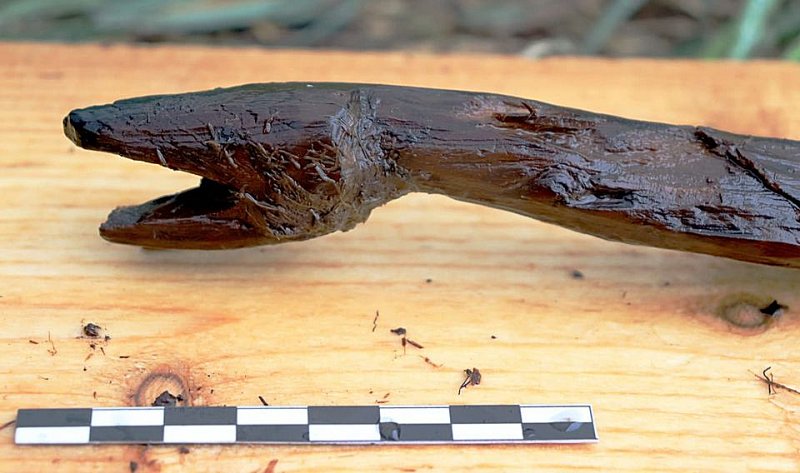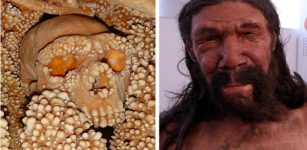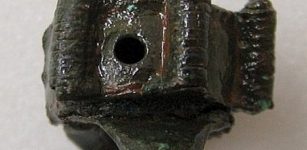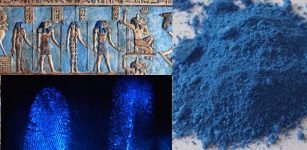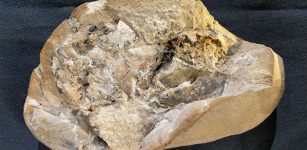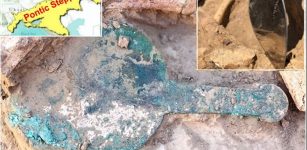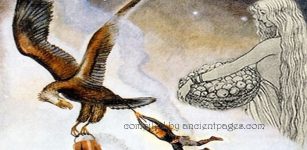4,000-Year-Old Serpent-Shaped Wooden Stick Unearthed in Southern Finland
Conny Waters - AncientPages.com - Archaeologists working at an excavation site near Järvensuo in southwest Finland have discovered a 4,000-year-old wooden stick shaped like a snake. The sculpture - the carefully carved, 50-centimeters-long artifact from the Neolithic Stone Age - was found under a layer of peat by the shore of Muinaisjärvi lake.
Radiocarbon dating of the object suggests it was made 4,400 years ago. Image: Satu Koivisto
"The snake looks like it's crawling or swimming to escape," University of Turku postdoctoral researcher Satu Koivisto said., adding that "based on the composition of the discovery deposit, the sculpture has either been lost, abandoned or placed in the dense coastal vegetation."
The radiocarbon dating of the object shows that the wooden stick was made approximately 4,400 years ago.
Yle writes that "from time to time, animal and human sculptures made of bone, horn, wood, stone or amber can be found in the prehistoric sites of the Fennoscandian Peninsula, which is the geographical peninsula comprising the Scandinavian and Kola Peninsulas, mainland Finland, and Karelia.
However, the 'Järvensuo snake' is currently the only one of its kind ever found. The discovery gives the possibility of better understand the artistic expression and ritual imagery of the people who once lived in the northern regions during the Stone Age.
The sculpture at the site (A) and being measured (B). Image: Satu Koivisto
Snakes are often depicted in the Stone Age rock art of Northern Europe, in addition to other animal and human figures. A number of rock paintings from the era appear to show a human figure either holding a real snake or a snake-shaped rod in its hand.
"We can of course never be certain of any connection between the Järvensuo snake and these paintings," Koivisto said. "However, the snake sculpture and a few other discoveries from Järvensuo last summer currently point to possible ritual activities alongside fishing and other everyday chores on the ancient lakeshore."
In addition to the snake sculpture, other well-preserved objects and scientific research materials have been discovered at the same site.
According to the study published in Antiquity, regarding the significance of the Järvensuo figurine, researchers say that "great caution must be exercised in interpreting a practically unique find such as the Järvensuo figurine, particularly as the character of the site is not yet fully understood. However, it seems reasonable to place the artifact in the religious sphere. Snakes are loaded with symbolic meaning in both Finno-Ugric and Sami cosmology, and shamans were believed to be able to transform into snakes.
Moreover, the Land of the Dead was believed to lie underwater, which seems interesting given the wetland setting of the Järvensuo figurine.
"These latest excavations have unearthed exceptionally well-preserved organic artifacts from the Stone Age era in the north, and such materials are a rarity in archaeological excavations. During the Stone Age, the place was located on the southern shore of Rautajärvi, which was overgrown and later dried up as arable land. Very rare Stone Age wood, bark, and tusk objects have been recovered," Koivisto added.
The three-year University of Turku study of the Stone Age site at Järvensuo is a continuation of work that began over 35 years ago after the site was drained in the 1950s. The lack of effective methods for excavating sites buried deep in wetlands has limited research in the area in Finland.
"More work should have been done earlier, as sensitive wetland sites are being destroyed at an accelerating rate. The biggest threats to survival are drainage, peat extraction, soil acidification, and climate change," Koivisto added.
Written by Conny Waters - AncientPages.com Staff Writer

